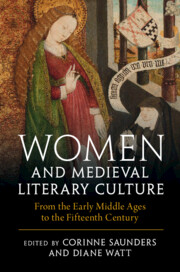Book contents
- Women and Medieval Literary Culture
- Women and Medieval Literary Culture
- Copyright page
- Contents
- Illustrations
- Contributors
- Acknowledgements
- Introduction
- I Patrons, Owners, Writers, and Readers in England and Europe
- II Circles and Communities in England
- III Health, Conduct, and Knowledge
- IV Genre and Gender
- Chapter 11 Lyrics
- Chapter 12 ‘It satte me wel bet ay in a cave / To bidde and rede on holy seyntes lyves’
- Chapter 13 Tears, Mediation, and Literary Entanglement
- Chapter 14 Convent and City
- Chapter 15 Women and Romance
- Chapter 16 Trouble and Strife in the Old French Fabliaux
- Chapter 17 Chaucer and Gower
- V Women as Authors
- General Index
- Index of Manuscripts
- References
Chapter 14 - Convent and City
Medieval Women and Drama
from IV - Genre and Gender
Published online by Cambridge University Press: 28 July 2023
- Women and Medieval Literary Culture
- Women and Medieval Literary Culture
- Copyright page
- Contents
- Illustrations
- Contributors
- Acknowledgements
- Introduction
- I Patrons, Owners, Writers, and Readers in England and Europe
- II Circles and Communities in England
- III Health, Conduct, and Knowledge
- IV Genre and Gender
- Chapter 11 Lyrics
- Chapter 12 ‘It satte me wel bet ay in a cave / To bidde and rede on holy seyntes lyves’
- Chapter 13 Tears, Mediation, and Literary Entanglement
- Chapter 14 Convent and City
- Chapter 15 Women and Romance
- Chapter 16 Trouble and Strife in the Old French Fabliaux
- Chapter 17 Chaucer and Gower
- V Women as Authors
- General Index
- Index of Manuscripts
- References
Summary
This essay examines medieval women dramatists, from Hrotsvitha of Gandersheim in tenth-century Germany, through Hildegard of Bingen and her Ordo Virtutum (Play of the Virtues) in the twelfth century, to Katherine Sutton, Abbess of Barking in the late fourteenth century, who composed liturgical dramas for Holy Week. The essay locates these women dramatists within the wider context of medieval convent performances in England and Europe, and shows that religious women were not only authors but also actors, directors, and costume makers; their convents provided the play space, while laywomen sometimes also contributed. Niebrzydowski also explores the often speculative or conjectural evidence for womenߣs participation in drama outside the convents. Although there is only one definitive English example of women as associated with a Corpus Christi production, a lost Chester pageant of ߢour Lady thassumpcionߣ, other fragmentary evidence suggests lay womenߣs involvement in a range of dramatic forms from saintsߣ lives, interludes, and morality plays to processions and pageants.
Keywords
- Type
- Chapter
- Information
- Women and Medieval Literary CultureFrom the Early Middle Ages to the Fifteenth Century, pp. 285 - 298Publisher: Cambridge University PressPrint publication year: 2023

